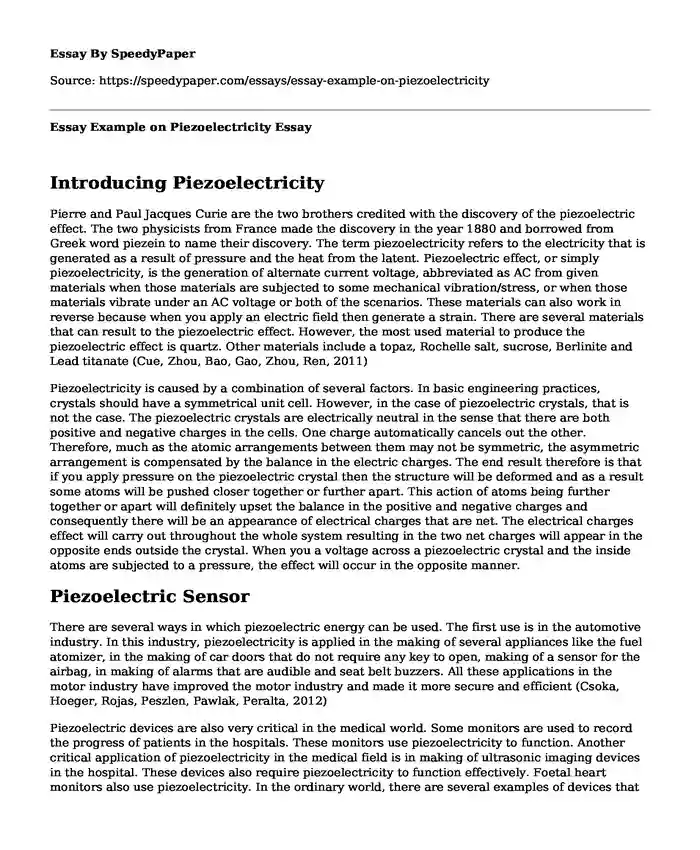Introducing Piezoelectricity
Pierre and Paul Jacques Curie are the two brothers credited with the discovery of the piezoelectric effect. The two physicists from France made the discovery in the year 1880 and borrowed from Greek word piezein to name their discovery. The term piezoelectricity refers to the electricity that is generated as a result of pressure and the heat from the latent. Piezoelectric effect, or simply piezoelectricity, is the generation of alternate current voltage, abbreviated as AC from given materials when those materials are subjected to some mechanical vibration/stress, or when those materials vibrate under an AC voltage or both of the scenarios. These materials can also work in reverse because when you apply an electric field then generate a strain. There are several materials that can result to the piezoelectric effect. However, the most used material to produce the piezoelectric effect is quartz. Other materials include a topaz, Rochelle salt, sucrose, Berlinite and Lead titanate (Cue, Zhou, Bao, Gao, Zhou, Ren, 2011)
Piezoelectricity is caused by a combination of several factors. In basic engineering practices, crystals should have a symmetrical unit cell. However, in the case of piezoelectric crystals, that is not the case. The piezoelectric crystals are electrically neutral in the sense that there are both positive and negative charges in the cells. One charge automatically cancels out the other. Therefore, much as the atomic arrangements between them may not be symmetric, the asymmetric arrangement is compensated by the balance in the electric charges. The end result therefore is that if you apply pressure on the piezoelectric crystal then the structure will be deformed and as a result some atoms will be pushed closer together or further apart. This action of atoms being further together or apart will definitely upset the balance in the positive and negative charges and consequently there will be an appearance of electrical charges that are net. The electrical charges effect will carry out throughout the whole system resulting in the two net charges will appear in the opposite ends outside the crystal. When you a voltage across a piezoelectric crystal and the inside atoms are subjected to a pressure, the effect will occur in the opposite manner.
Piezoelectric Sensor
There are several ways in which piezoelectric energy can be used. The first use is in the automotive industry. In this industry, piezoelectricity is applied in the making of several appliances like the fuel atomizer, in the making of car doors that do not require any key to open, making of a sensor for the airbag, in making of alarms that are audible and seat belt buzzers. All these applications in the motor industry have improved the motor industry and made it more secure and efficient (Csoka, Hoeger, Rojas, Peszlen, Pawlak, Peralta, 2012)
Piezoelectric devices are also very critical in the medical world. Some monitors are used to record the progress of patients in the hospitals. These monitors use piezoelectricity to function. Another critical application of piezoelectricity in the medical field is in making of ultrasonic imaging devices in the hospital. These devices also require piezoelectricity to function effectively. Foetal heart monitors also use piezoelectricity. In the ordinary world, there are several examples of devices that use piezoelectricity to operate. One such device is the cigarette lighter used by smokers to light cigarettes. Musical instruments also require the energy from piezoelectricity to operate as the case with speakers. People who have quartz watches should know that those watches operate on piezoelectric energy. The watch's electrical energy is fed into the piezoelectric crystal to enable the watch to oscillate many times a second. In the computer world, piezoelectricity is used in disc drives and inkjet printers (Viola, Saunders, Wey, Chong, Luo, Reece, Yan, 2013).
For a microphone to convert the energy of the sound into the energy that is electrical, there has to be reliance on piezoelectric crystals for it to happen.
References
Csoka, L., Hoeger, I. C., Rojas, O. J., Peszlen, I., Pawlak, J. J., & Peralta, P. N. (2012). Piezoelectric effect of cellulose nanocrystals thin films. ACS Macro Letters, 1(7), 867-870.
Viola, G., Saunders, T., Wei, X., Chong, K. B., Luo, H., Reece, M. J., & Yan, H. (2013). The contribution of the piezoelectric effect, electrostriction and ferroelectric/ferroelastic switching to strain-electric field response of dielectrics. Journal of Advanced Dielectrics, 3(01), 1350007.
Xue, D., Zhou, Y., Bao, H., Gao, J., Zhou, C., & Ren, X. (2011). Large piezoelectric effect in Pb-free Ba (Ti, Sn) O3-x (Ba, Ca) TiO3 ceramics. Applied physics letters, 99(12), 122901.
Cite this page
Essay Example on Piezoelectricity. (2022, Jun 15). Retrieved from https://speedypaper.net/essays/essay-example-on-piezoelectricity
Request Removal
If you are the original author of this essay and no longer wish to have it published on the SpeedyPaper website, please click below to request its removal:
- Essay Sample: Customer Experience Research
- The Impact of Digital Technology Essay Example
- Free Paper with a Research Proposal on the O-Arm Imaging System Safety
- Free Essay: Accommodations for Disables Employees and Cross-Cultural Communication in the Workplace
- Essay Sample on Description of the Workflow Process
- Paper Example on the Law of Contract
- Gender and Sexuality. Essay Sample
Popular categories





